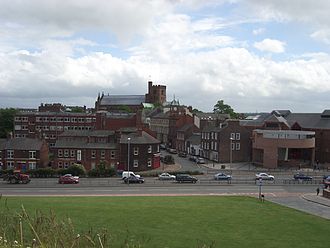Cumbria Way
The Cumbria Way is an unfortunately named linear long distance footpath 70 miles long through three counties, passing from Morecambe Bay through the Lake District and on to within sight of the Solway Firth. It thus links Lancashire, Westmorland and Cumberland.
The Way links Ulverston in Lancashire in the south with Carlisle, the county town of Cumberland in the north, and on its way passes through a number of pretty towns - Ulverston and Coniston in Lancashire and Keswick and finally Carlisle in Cumberland. It also passes through famous dales including Great Langdale and Borrowdale. The majority of the route is inside the boundaries of the Lake District National Park.
The route cuts through classic Lakeland country by way of Coniston Water, Great Langdale, Borrowdale, Derwent Water, Skiddaw Forest and Caldbeck. It is a primarily low-level long distance footpath but does contain some high-level exposed sections.[1]
The highest point on the route is at High Pike in the Northern Fells, in Cumberland, at 2,160 feet above sea level.
History
The Way was originally devised in the 1970s by local Ramblers' Association members. The waymarking of the entire route was completed by volunteers and national park staff in May 2007. [2]
Route
The trailheads are at:
- Ulverston, Lancashire: 54°11’42"N, 3°5’31"W, SD284785
- Carlisle, Cumberland: 54°53’42"N, 2°56’2"W, NY400554
The route can be walked in either direction but described from south to north, beginning at the trailhead of Ulverston and ending in Carlisle, it has the following recommended stages:
Stage 1: Ulverston to Coniston
- (Lancashire;15 miles)
The route leaves the urban area of Ulverston, and heads north towards the village of Gawthwaite (the boundary of the National Park). The route, which consists primarily of field paths at this stage, then progresses towards Sunny Bank and the shore of Coniston Water.
The western shoreline of Coniston Water is followed before reaching the village of Coniston. [3]
Grizedale Forest is visible to the east of the lake with the Old Man of Coniston, Lancashire's county top, and Dow Crag visible to the west on approach to Coniston village.
Stage 2: Coniston to Langdale
- (Lancashire, Westmorland; 11 miles)
The route leaves Coniston heading north-north-west through woodland towards Tarn Hows. The route involves some road walking as it passes through the villages of Colwith and Skelwith Bridge, where it crosses the River Brathay into Westmorland.
The Langdale Pikes soon become visible as the route leaves Skelwith Bridge in a north-north-easterly direction, passing Elter Water (which contains Lancashire’s northernmost point) before entering Great Langdale.[4]
Stage 3: Langdale to Keswick
- (Westmorland, Cumberland; 15 miles)
The route leaves Langdale and travels alongside Mickleden Beck. The mountain of Bow Fell passed to the west with the Langdale Pikes to the east. After a significant gain in elevation the route crosses Stake Pass, where the route enters its last county, Cumberland.
From Stake Pass the route descends by way of Langstrath Beck and turning towards the villages of Stonethwaite and Rosthwaite. The route subsequently follows the River Derwent before reaching Derwent Water where it follows the shoreline path to reach the town of Keswick.
The mountains Skiddaw and Blencathra may be visible to the north.[5]
Stage 4: Keswick to Caldbeck
- (Cumberland; 14 miles)
After some town walking through Keswick, the route crosses the A591 road before ascending past Latrigg towards Skiddaw House at 1,526 feet. Skiddaw House was previously a shepherd's bothy and a shooting lodge, and now provides youth hostel accommodation in season. After crossing the area of fells known as Back o' Skiddaw the route passes High Pike and the Caldbeck Fells before descending towards the village of Caldbeck.[6]
Stage 5: Caldbeck to Carlisle
- (Cumberland; 15 miles)

After leaving the village of Caldbeck the route follows a low-level path follownig the course of the River Caldew to Cumberland's county town, Carlisle. The route passes through such villages as Sebergham, Buckabank and Dalston following primarily woodland and farmland public footpaths and bridleways.[7]
Geology and Biology
Flora and Fauna
The tarns encountered on the route provide a habitat for a wide range of species including vendace, charr, crayfish and schelly.[8]
The red squirrel can be found in woodland encountered on the route.[9]
The ancient woodland encountered throughout the route provide a favourable habitat, due to high precipitation, for mosses, liverworts, ferns and lichens. The boggy areas encountered, particularly during the high-level parts of the route, provide a habitat for carnivorous plants including sundew and butterwort.
Connecting trails
The route connects with the Allerdale Ramble, the Coast to Coast Walk, the Hadrian's Wall Path, the Cistercian Way, the Eden Way and the Windermere Way.
Outside links
| ("Wikimedia Commons" has material about Cumbria Way) |
- Ramblers Association
- Cumbria Way
- Long Distance Walkers Association
- Route of the Way delineated in 2-mile sections
References
- ↑ Paths. Recreational Route: Cumbria Way – The Ramblers Association
- ↑ Crawford, S (2007-05-30). "Marking the way for walkers". Cumberland News. http://beta.cumberland-news.co.uk/1.74045. Retrieved 2008-05-17.
- ↑ Cumbria Way Stage 1 - Ulverston.net
- ↑ Cumbria Way Stage 2 - Ulverston.net
- ↑ Cumbria Way Stage 3 - Ulverston.net
- ↑ Cumbria Way Stage 4 - Ulverston.net
- ↑ Cumbria Way Stage 5 - Ulverston.net
- ↑ Lake District Special Properties - The Lake District National Park Authority
- ↑ "Understanding Wildlife". The Lake District National Park Authority. http://www.lake-district.gov.uk/index/understanding/posters/poster4_wildlife.htm. Retrieved 2008-05-17.
- The Cumbria Way and the Allerdale Ramble, Jim Watson, Cicerone Press, ISBN 978-1-85284-242-0
- The Cumbria Way, Anthony Burton, ISBN 1-85410-615-5. Aurum Press.
- The Cumbria Way, John Trevelyan, ISBN 1-85568-197-8. Dalesman